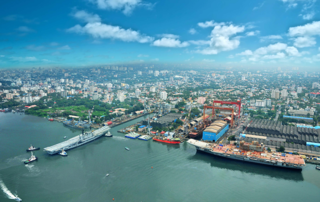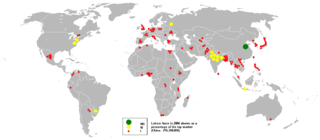Related Research Articles

As of June 2023, the population of Singapore stands at 5.92 million. Of these 5.92 million people, 4.15 million are residents, consisting of 3.61 million citizens and 540,000 permanent residents (PRs). The remaining 1.77 million people living in Singapore are classed as non-residents, a group consisting mainly of resident workers without political rights who are routinely excluded from official demographic statistics.

Unemployment, according to the OECD, is people above a specified age not being in paid employment or self-employment but currently available for work during the reference period.

The economy of Singapore is a highly developed mixed market economy with dirigiste characteristics. Singapore's economy has been consistently ranked as the most open in the world, the joint 4th-least corrupt, and the most pro-business. Singapore has low tax-rates and the second highest per-capita GDP in the world in terms of purchasing power parity (PPP). The Asia-Pacific Economic Cooperation (APEC) is headquartered in Singapore.

Underemployment is the underuse of a worker because their job does not use their skills, offers them too few hours, or leaves the worker idle. It is contrasted with unemployment, where a person lacks a job at all despite wanting one.

Real wages are wages adjusted for inflation, or, equivalently, wages in terms of the amount of goods and services that can be bought. This term is used in contrast to nominal wages or unadjusted wages.

The Central Provident Fund Board (CPFB), commonly known as the CPF Board or simply the Central Provident Fund (CPF), is a compulsory comprehensive savings and pension plan for working Singaporeans and permanent residents primarily to fund their retirement, healthcare, and housing needs in Singapore.
The National Registration Identity Card (NRIC), colloquially known as "IC", is a compulsory identity document issued to citizens and permanent residents of Singapore. People must register for an NRIC within one year of attaining the age of 15, or upon becoming a citizen or permanent resident. Re-registrations are required for persons attaining the ages of 30 and 55, unless the person has been issued with an NRIC within ten years prior to the re-registration ages.

Singapore maintains an active conscription system in accordance with the regulations set by the Government of Singapore, known as National Service (NS). This requires all qualified male Singaporean citizens and second-generation permanent residents to serve a period of active duty military service in the uniformed services.

The economy of Kerala is the 9th largest in India, with an annual gross state product (GSP) of ₹9.78 lakh crore in 2020–2021. Per-capita GSP of Kerala during the same period is ₹257,711 (US$3,100), the sixth largest in India. In 2019–20, the tertiary sector contributed around 63% of the state's GSVA, compared to 28% by secondary sector, and 8% by primary sector.
Graduate unemployment, or educated unemployment, is unemployment among people with an academic degree.
Immigration to Singapore is the process by which people migrate to Singapore for the purpose of residing there—and where a majority go on to become permanent residents and Singaporean citizens. Singapore is an attractive destination especially in the region as it is a country with a strong currency that offers high living standards, including in education, work, wages and safety as well as an overall far higher quality of life compared to its neighbours. High-net-worth or skilled immigrants worldwide are also attracted to Singapore's low tax rates and ease of doing business.

The Ministry of Manpower is a ministry of the Government of Singapore responsible for the formulation and implementation of policies related to the workforce in Singapore.

Foo Mee Har is a Malaysian-born Singaporean politician and businesswoman. She is a member of the governing People's Action Party (PAP). Foo has served as the Member of Parliament (MP) for the Ayer Rajah division from 2011 to 2020. Since 2020, she represents the Ayer Rajah-Gek Poh division, a result of the merger between the Jurong West portion of Hong Kah North SMC and West Coast GRC's Ayer Rajah ward.

Unemployment in the United Kingdom is measured by the Office for National Statistics. As of February 2024, the U.K. unemployment rate is 3.8%, down from 3.9% in January.
The National Trades Union Congress (NTUC) spearheads the labour movement of Singapore, which represents almost a million workers in the country across more than 70 unions, affiliated associations and related organisations. Singapore runs on a tripartism model which aims to offers competitive advantages for the country by promoting economic competitiveness, harmonious government-labour-management relations and the overall progress of the nation.
Fair Consideration Framework (FCF) is a guideline announced by Singapore's Ministry of Manpower that requires employers to consider Singaporeans fairly for all job opportunities before hiring Employment Pass (EP) holders. The FCF was announced on 23 September 2013 and was a result from the feedback received through MOM's "Our Singapore Conversation" sessions, employer groups and key stakeholders such as the National Trades Union Congress (NTUC).

Singaporeans First (SingFirst) was a political party in Singapore founded on 25 May 2014. The party was dissolved on 25 June 2020.

Nepal has a labour force of 16.8 million workers, the 37th largest in the world as of 2017. Although agriculture makes up only about 28 per cent of Nepal's GDP, it employs more than two-thirds of the workforce. Millions of men work as unskilled labourers in foreign countries, leaving the household, agriculture, and raising of children to women alone. Most of the working-age women are employed in the agricultural sector, contributions to which are usually ignored or undervalued in official statistics. Few women who are employed in the formal sectors face discrimination and significant wage gap. Almost half of all children are economically active, half of which are child labourers. Millions of people, men, women and children of both sexes, are employed as bonded labourers, in slavery-like conditions. Trade unions have played a significant role in bringing about better working conditions and workers' rights, both at the company level and the national government level. Worker-friendly labour laws, endorsed by the labour unions as well as business owners, provide a framework for better working conditions and secure future for the employees, but their implementation is severely lacking in practice. Among the highly educated, there is a significant brain-drain, posing a significant hurdle in fulfilling the demand for skilled workforce in the country.
Malaysians in Singapore refers to citizens of Malaysia or Singaporean citizens of Malaysia origin residing in Singapore. According to the United Nations Department of Economic and Social Affairs, the community had a population of 1,132,924 in 2020, making them the world's largest Malaysian diaspora community. The community is also the largest foreign community in Singapore, constituting 44% of the country's foreign-born population and an additional 350,000 Malaysians cross the Johor–Singapore Causeway daily for work and school in the city-state.
Chinese nationals in Singapore refers to Chinese people who are of Chinese nationality residing in Singapore. According to the United Nations Department of Economic and Social Affairs, the community had a population of 514,110 in 2020, with 65,867 originating from Hong Kong and 21,809 from Macau, the 2 special administrative regions of China. The community of Chinese nationals are the 2nd largest foreign community in Singapore, constituting 18% of the country's foreign-born population.
References
- ↑ "Ministry of Manpower". Archived from the original on 19 January 2016. Retrieved 28 December 2015.
- ↑ "Statistics Singapore Latest Data". Archived from the original on 29 November 2015. Retrieved 26 December 2015.
- ↑ "World Bank: Population Density". data.worldbank.org. Archived from the original on 16 May 2015. Retrieved 26 December 2015.
- ↑ "Employment Act - Singapore". Asiapedia. Dezan Shira and Associates. Archived from the original on 15 February 2019. Retrieved 7 March 2023.
- ↑ "Employment Act: who it covers". Ministry of Manpower Singapore. Archived from the original on 13 February 2023. Retrieved 7 March 2023.
- ↑ "Employment in Singapore". Careers Future. Workforce Singapore. Retrieved 9 November 2018.[ permanent dead link ]
- ↑ "Summary Table: Employment". stats.mom.gov.sg. Archived from the original on 23 October 2019. Retrieved 7 March 2023.
- 1 2 "LABOUR MARKET THIRD QUARTER 2015" (PDF). stats.mom.gov.sg. December 2005. Retrieved 7 March 2023.
- 1 2 See, Sharon (9 February 2021). "Underemployment a bigger issue than unemployment: economists". Business Times . Archived from the original on 7 March 2023. Retrieved 7 March 2023.
- ↑ cue (9 January 2023). "Singapore unemployment rates stay low in November: MOM | The Straits Times". www.straitstimes.com. Archived from the original on 20 January 2023. Retrieved 7 March 2023.
- ↑ "Fewer workers laid off in Q1, but no improvement to long-term unemployment rate: MOM figures". The Straits Times. 13 June 2017. Archived from the original on 24 May 2022. Retrieved 7 March 2023.
- ↑ "Commentary: Help our 'graduate poor' break out of the underemployment trap". CNA. Archived from the original on 30 April 2018. Retrieved 29 April 2018.
- ↑ "Are we working too much? Singaporeans at risk of developing health problems due to long hours". AsiaOne. 28 July 2017. Archived from the original on 30 November 2022. Retrieved 7 March 2023.
- ↑ Low, Vincent. "ST says more openings for PMETs but MAS MD wants more foreign PMETs to be hired". The Online Citizen. Archived from the original on 10 November 2018. Retrieved 9 November 2018.
- ↑ "More employees in Singapore working beyond retirement age". HRM Asia. 9 February 2023. Archived from the original on 10 February 2023. Retrieved 7 March 2023.